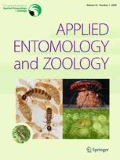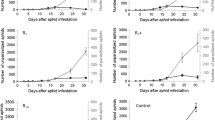Abstract
Banker-plant systems with Aphidius species have been used to control pest aphids in greenhouses in Japan. However, the occurrence of secondary parasitoids, which lead to aphid-control failures, and of minor aphid species, are problematic. In this work the ecological characteristics of Ephedrus nacheri Quilis (Hymenoptera: Braconidae), an alternative biological control agent to Aphidius species against the pest aphids Aphis gossypii and Myzus persicae, were examined under laboratory conditions at 25 °C. Attack rate, success of parasitization, and offspring sex ratio were highly dependent on aphid species and instar stage. Development time and offspring body size depended on aphid species. Because of insufficient honeydew production, survival of the female wasp decreased when the host density was low; as a result, a type III functional response curve was observed for the two aphid species in most stage combinations. The intrinsic rate of natural increase estimated by use of the bootstrap method ranged from 0.128 to 0.258, depending on the larval mortality, host species, and stage. These values were insufficient to support inoculative use of E. nacheri for aphid control. In future work we will conduct a survey to discover a better combination of banker plant and host aphid which maintains a sufficient population and offspring sex-ratio, and decide the scale of the banker-plant system in the greenhouse that will supply a sufficient wasp population.






Similar content being viewed by others
References
Abe J, Mitsunaga T, Kumakura H, Yano E (2011) Comparative studies on development and reproduction of four cereal aphid species reared on sorghum or barley to evaluate as alternative prey for banker plant system. Jpn J Appl Entomol Zool 55:227–239 (in Japanese with English summary)
Almeida RP (2001) Effect of the population levels of Aphis gossypii on cotton agronomic trairs and fibre quality. Proc Exp Appl Entomol NEV Amsterdam 12:97–100
Bass C, Puinean AM, Andrews MC, Culter P, Daniels M, Elias J, Laura Paul V, Crossthwaite AJ, Denholm I, Field LM, Foster SP, Lind R, Williamson MS, Slater R (2011) Mutation of a nicotinic acetylcholine receptor β subunit is associated with resistance to neonicotinoid insecticides in the aphid Myzus persicae. BMC Neurosci 12:51
Charnov EL, Los-den Hartogh RL, Jones WT, van den Assem J (1981) Sex ratio evolution in a variable environment. Nature 289:27–33
Cloutier C, Lévesque CA, Eaves DM, Mackauer M (1991) Maternal adjustment of sex ratio in response to host size in the aphid parasitoid Ephedrus californicus. Can J Zool 69:1489–1495
Desneux N, Fauvergue X, Moncharmont FXD, Kerhoas L, Ballanger Y, Kaiser L (2005) Diaeretiella rapae limits Myzus persicae populations after application of deltamethrin in oilseed rape. J Econ Entomol 98:9–17
Efton B (1982) The jackknife, the bootstrap and other resampling plans. Society for Industrial and Applied Mathematics, Philadelphia
Elliot NC, French BW, Burd JD, Kindler SD, Reed DK (1994) Parasitism, adult emergence, sex ratio, and size of Aphidius colemani (Hymenoptera: Aphididae) on several aphid species. The Great Lake Entomol. 27:137–142
Fischer MK, Shingleton AW (2001) Host plant and ants influence the honeydew sugar composition of aphids. Funct Ecol 15:544–550
Fujii K, Holling CS, Mace PM (1986) A simple generalized model of attack by predators and parasites. Ecol Res 1:141–156
Hansen LS (1983) Introduction of Aphidoletes aphidimyza (Rond.) (Diptera: Cecidomyiidae) from an open rearing unit for the control of aphids in glasshouses. Bull IOBC/WPRS 6:146–150
Hassell MP (1978) The dynamics of arthropod predator-prey systems. Princeton Univ Press, Princeton, p 237
Hogervorst PAM, Wäckers FL, Romeis J (2007) Effects of honeydew sugar composition on the longevity of Aphidius ervi. Entomol Exp Appl 122:223–232
King BH (1989) Host-size dependent sex ratios among parasitoid wasps: does host growth matter? Oecologia 78:420–426
Matsuura A, Nakamura M (2014) Development of neonicotinoid resistance in the cotton aphid Aphis gossypii (Hemiptera: Aphididae) in Japan. Appl Entomol Zool 49:535–540
Meyer JS, Ingersoll CG, McDonald LL, Boyce MS (1986) Estimating uncertainty in population growth rates: jackknife and bootstrap techniques. Ecology 67:1156–1166
Mitsunaga T, Shimoda T, Yano E (2004) Influence of food supply on longevity and parasitization ability of a larval endoparasitoid, Cotesia plutellae (Hymenoptera: Braconidae). Appl Entomol Zool 39:691–697
Nagasaka K, Oya S (2003) A practical application of a banker plant system to aphid control in greenhouse. Plant Prot 57:505–509 (in Japanese)
Nagasaka K, Takahasi N, Okabayashi T (2010a) Impact of secondary parasitism on Aphidius colemani in the banker plant system on aphid control in commercial greenhouses in Kochi, Japan. Appl Entomol Zool 45:541–550
Nagasaka K, Takahashi N, Okabayashi T, Abe J, Oya S (2010b) Development of a practical banker plant system for aphid control in commercial greenhouse crops in Japan. Bull Natl Agric Res Cent 15:1–50 (in Japanese with English summery)
Ohta I, Ohtaishi M (2004) Fertility, longevity, and intrinsic rate of increase of Aphidius gifuensis Ashmead (Hymenoptera: Braconidae) on the green peach aphid, Myzus persicae (Sulzer) (Homoptera: Aphididae). Appl Entomol Zool 39:113–117
Pelletier Y, Pompon J, Dexter P, Quiring D (2010) Biological performance of Myzus persicae and Macrosiphum euphorbiae (Homoptera: Aphididae) on seven wild Solanum species. Ann Appl Biol 156:329–336
SAS Institute (2009) JMP, version 8.0.1, SAS Institute, Cary
Takada H (1968) Aphidiidae of Japan (Hymenoptera). Insecta Matsum 30:67–124
Takada H (2002) Parasitoids (Hymenoptera: Braconidae, Aphidiinae; Aphelinidae) of four principal pest aphids (Homoptera: Aphididae) on greenhouse vegetable crops in Japan. Appl Entomol Zool 37:237–249
Tomanovic Z, Petrovic A, Stary P, Kavallieratos NG, Zikic V, Rakhshani E (2009) Ephedrus Haliday (Hymenoptera: Braconidae: Aphidiinae) in Serbia and Montenegro: tritrophic associations and key. Acta Entomol Serbica 14:39–53
van den Assem J, Putters FA, Prins T (1984) Host quality effects on sex ratio of the parasitic wasp Anisopteromalus calandrae (Chalcidoidea, Pteromalidae). Nether J Zool 34:33–62
van Lenteren JC, Woets J (1988) Biological and integrated pest control in greenhouses. Ann Rev Entomol 33:239–269
van Steenis MJ (1995) Evaluation and application of parasitoids of biological control of Aphis gossypii in glasshouse cucumber crops. PhD thesis. Wageningen Agricultural Univ. pp 215
Vinson BS (1976) Host selection by insect parasitoids. Ann Rev Entomol 21:109–133
Werren JH (1984) A model for sex ratio selection in parasitic wasps: local mate competition and host quality effects. Nether J Zool 34:81–96
Wolfram Research (2004) Mathematica, version 5.1, Wolfram Research Inc., Champaign
Yano E (2006) Ecological considerations for biological control of aphids in protected culture. Popul Ecol 48:333–339
Yashima K, Murai T (2013) Development and reproduction of a potential biological control agent, Aphelinus varipes (Hymenoptera: Aphelinidae), at different temperatures. Appl Entomol Zool 48:21–26
Acknowledgments
We thank Mr H. Tanaka and Ms A. Iwasaki for rearing the insects and plants. This study was supported by the Science and Technology Research Program for Agriculture, Forestry, Fisheries and Food Industry (grant number 25042B).
Author information
Authors and Affiliations
Corresponding author
Rights and permissions
About this article
Cite this article
Mitsunaga, T., Moriya, S., Nagasaka, K. et al. Host species-dependent and size-dependent ecological characteristics of Ephedrus nacheri (Hymenoptera: Braconidae). Appl Entomol Zool 50, 465–475 (2015). https://doi.org/10.1007/s13355-015-0354-7
Received:
Accepted:
Published:
Issue Date:
DOI: https://doi.org/10.1007/s13355-015-0354-7




